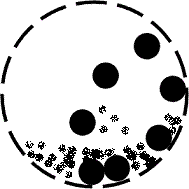Here is a list of Rules of Thumb often used in Grinding Circuits:
- Fine ore bins (or stockpiles) that provide feed to the grinding circuit should have a capacity equal to 30 hours of processing. Source: Northern Miner
- Press Grinding is a low-efficiency, power-intensive process and typically can account for up to 40% of the direct operating cost of the mineral processing plant. Source: Callow and Kenyen
- For purposes of design, it may be assumed that a “smaller” ball mill will carry a 40% charge of steel balls; however, the drive should be designed for a charge of 45%. Source: Denver Equipment Company
In today’s ultra large ball mills of up to 28′ diameter and 44′ long;
a 28-32% ball charge is your maximum. Source: Paul Staples - A grate (diaphragm) discharge ball mill will consume 15% more power than an overflow
(open) discharge ball mill even though the grinding efficiencies are the same. Source: Lewis, Coburn, and Bhappu - Other things being equal, the larger diameter the drum, the more efficient the grinding. However, this phenomenon stops when the diameter reaches 12.5 feet (3.8m). Thereafter, the efficiency bears no relation to diameter. Source: Callow and Kenyen
- The ball mill diameter should not exceed 100 times the diameter of the grinding media. Source: Bond and Myers
- In pebble mills, the individual pieces of media should be the same weight, not the same volume, as the optimum size of steel ball. Source: Bunting Crocker
- The power draft (draw) in a pebble mill can easily, quickly, and automatically be controlled to an extent that cannot be done on a ball mill. Source: Bunting Crocker
The ratio of length to diameter of a rod mill should not exceed 1.4:1 and the maximum length of a rod (to avoid bending) is 20 feet. As a result, the largest rod mill manufactured measures fifteen feet diameter and is 21 feet in length. Source: Lewis, Coburn, and Bhappu  For most applications, 70:1 is the maximum practical reduction factor (ratio) for a ball mill, but 60:1 represents typical design practice. Source: Jack de la Vergne
For most applications, 70:1 is the maximum practical reduction factor (ratio) for a ball mill, but 60:1 represents typical design practice. Source: Jack de la Vergne- Rubber liners in ball mills may have a service life of 2-3 times that of steel liners. Source: W. N. Wallinger
- The capacity of a mill with synthetic rubber liners is approximately 90% that of the same unit with steel liners. Source: Yanko Tirado
- The capacity of a grinding mill for a given product operating in open circuit is only 80% that of the same unit operating in closed circuit. Source: Lewis, Coburn and Bhappu
- A dual drive (i.e. twin motors and pinions driving a single ring gear) may be more economical than a single drive when the grinding mill is designed to draw more than 6,000 HP (4.5 Mw). Source: Rowland and Kjos
As of 2015 however, single pinion mills are viable and cost effective up to at least 8WM and perhaps 10MW. Source: Paul Staples - The ratio of diameters between the vortex finder (overflow exit) and the apex (underflow exit) of a hydrocyclone classifier must be kept greater than 2:1, otherwise operation may be unpredictable. Source: Chuck Lagergren and Gary Lubers
- Mill power is nearly proportional to revolutions per minute (rpm); new liner designs allow for greater mill rpm; e.g., 20-ft-diameter mill at 77% of Cs, thus more throughput.
- Older %Cs rules of thumb are shown here:

Crushing Rule of Thumb
Froth Flotation Rule of Thumb
Mineral Processing / Metallurgy Rule of Thumb
Hard Rock Miners Handbook – Edition 3 originally published by McIntosh Engineering in June 2003 now Stantec.
